Have you ever come across a gorgeous, blush-colored onion at the market and wondered, What’s the deal with pink onions? Well, you’re not alone! These beauties aren’t as common as their red, white, or yellow cousins, but trust me—once you start using them, you’ll never look back.
Pink onions bring the best of both worlds: they have the mild sweetness of red onions but without the overpowering sharpness of white onions. Whether you’re tossing them into salads, sautéing them for a pasta dish, or pickling them for tacos, pink onions add a pop of color and a subtle, well-balanced flavor that makes any dish stand out.

But what exactly are pink onions, and why should you use them instead of regular onions? Let’s dive in!
“Pink onions are like the secret ingredient you never knew you needed—mild, slightly sweet, and full of flavor without being overpowering.”
Table of Contents
What Are Pink Onions?
How Pink Onions Differ from Red, White, and Yellow Onions
At first glance, pink onions might look like a cross between red and white onions, and that’s exactly how they taste! Unlike red onions, which can sometimes be too pungent when eaten raw, pink onions have a gentler bite, making them perfect for salads and garnishes.
Here’s how they compare to other onions:
| Onion Type | Flavor Profile | Best Uses |
|---|---|---|
| Pink Onions | Mild, slightly sweet, with a balanced tang | Raw in salads, pickled, sautéed |
| Red Onions | Strong, sharp, slightly sweet | Raw in burgers, salads, sandwiches |
| White Onions | Sharp, intense, and slightly spicy | Salsas, stir-fries, soups |
| Yellow Onions | Classic onion flavor, strong when raw, mellow when cooked | Soups, stews, caramelized |
The Unique Flavor and Appearance of Rosy onions
Rosy onions have a soft pink hue on their outer layers, with a slightly translucent, whitish-pink interior. Their flavor is mild enough to enjoy raw but still bold enough to enhance cooked dishes.
“Think of pink onions as the ‘middle child’ of the onion family—often overlooked but secretly the most versatile!”
You can use them in place of red onions for a less aggressive onion flavor or swap them for white onions when you want a hint of sweetness without the harsh bite.
Health Benefits of Rosy onions
Not only do Rosy onions taste amazing, but they’re also packed with nutrients and health benefits. Here’s why you should be adding them to your meals:
1. Packed with Antioxidants & Vitamins 🧅✨
Pink onions are loaded with flavonoids and anthocyanins, which are powerful antioxidants that help fight inflammation and protect your cells from damage. They also contain vitamin C, which boosts your immune system and helps your body absorb iron.
2. Supports Digestion & Gut Health
Ever heard that onions are good for your gut? That’s because they’re rich in prebiotic fiber, which feeds the good bacteria in your digestive system. A healthy gut means better digestion, improved immunity, and even better mood regulation!
3. Helps Lower Blood Sugar & Cholesterol
Studies have shown that onions—especially raw ones—can help lower blood sugar levels and improve heart health by reducing cholesterol. Pink onions contain quercetin, a compound known for its anti-inflammatory and blood pressure-lowering properties.
4. Pink Onions vs. Other Onions: Which Is Healthier?
All onions have health benefits, but pink onions have a special edge:
✔ Less harsh on the stomach compared to white onions.
✔ More antioxidants than yellow onions.
✔ Sweeter & milder, making them easier to eat raw in larger quantities.
So, next time you’re shopping for onions, consider grabbing some pink ones—they’re delicious AND great for your health!
How to Cook with Rosy onions
So now that you know how amazing pink onions are, the real question is—how do you cook with them? The answer: any way you like! Whether you love them raw, caramelized, or pickled, pink onions can transform your dishes with their mild, slightly sweet flavor.
Here’s everything you need to know about cooking with pink onions.
Best Cooking Methods: Raw, Sautéed, Roasted & Pickled
1. Enjoy Them Raw for a Fresh, Crisp Bite
Rosy onions are less pungent than red onions, making them perfect for raw dishes. Slice them thin and toss them into:
✔ Salads – Adds a pop of color and crunch.
✔ Burgers & Sandwiches – A mild yet flavorful upgrade.
✔ Salsas & Guacamole – Enhances freshness without overpowering.
Pro Tip: If you find raw onions a bit strong, soak sliced pink onions in cold water for 10 minutes to mellow their sharpness.
2. Sautéing for a Soft, Flavorful Addition
Sautéing Rosy onions brings out their natural sweetness and makes them an excellent base for many dishes. To sauté:
✔ Heat 1 tbsp of olive oil or butter in a pan.
✔ Add thinly sliced Rosy onions and cook over medium heat for 5-7 minutes, stirring occasionally.
✔ Use them in pasta, stir-fries, omelets, or tacos!
Pro Tip: Add a pinch of salt while sautéing to help the onions release moisture and cook faster.
3. Roasting for a Deep, Sweet Flavor
Want onions with bold, caramelized flavor? Roasting is the way to go!
✔ Preheat oven to 400°F (200°C).
✔ Toss pink onion wedges with olive oil, salt, and pepper.
✔ Roast for 20-25 minutes until golden and slightly crispy.
Roasted pink onions taste amazing in grain bowls, roasted veggie platters, or as a pizza topping!
4. Pickling for a Tangy, Vibrant Twist 🫙
Pickled Rosy onions are a game-changer! They add a zesty, slightly sweet kick to tacos, sandwiches, grain bowls, and more.
Here’s a super easy pink onion pickling recipe:
Quick Pickled Pink Onions Recipe
Ingredients:
- 1 large pink onion (thinly sliced)
- ½ cup apple cider vinegar
- ½ cup water
- 1 tbsp sugar
- 1 tsp salt
Prep & Cooking Time:
- Prep Time: 5 minutes
- Cooking Time: 2 minutes
- Total Time: 10 minutes (plus resting time)
- Servings: 6
- Calories per serving: ~10 kcal
Instructions:
- Thinly slice the Rosy onions and place it in a clean jar.
- In a small saucepan, combine vinegar, water, sugar, and salt. Bring to a gentle boil.
- Pour the hot mixture over the onions in the jar.
- Let it sit for at least 30 minutes before using. (For best flavor, refrigerate overnight!)

“A little jar of pickled pink onions in your fridge is like having a flavor bomb ready to elevate any meal!”
Common Problems & Solutions When Using Rosy onions
Cooking with Rosy onions is usually easy, but here are some common problems and how to fix them!
1. My Pink Onions Are Too Spicy!
Solution: Soak them in cold water for 10-15 minutes before using. This tones down the sharpness while keeping their crisp texture.
2. How Do I Store Rosy onions for Maximum Freshness?
Solution:
- Whole onions: Store in a cool, dry place (NOT the fridge!) for up to 2 months.
- Sliced onions: Keep in an airtight container in the fridge for up to 5 days.
3. My Onions Turn Bitter When Cooking!
Solution: Cook them on medium or low heat. High heat burns onions quickly, making them taste bitter
Where to Buy and How to Choose the Best Rosy onions
Now that you know how to cook with Rosy onions, the next question is—where can you find them? While they might not be as common as red or yellow onions, pink onions are becoming increasingly popular in grocery stores and farmers’ markets. Here’s how to find the best quality pink onions and store them properly.
Where to Buy Pink Onions
✔ Supermarkets: Some major grocery stores stock Rosy onions, especially in the produce section near red and white onions. If you don’t see them, ask a store employee!
✔ Farmers’ Markets: The best place to find fresh, locally grown pink onions. Plus, they often have a stronger, sweeter flavor compared to mass-produced ones.
✔ Specialty Grocery Stores: Organic food stores and international markets (especially Indian, Middle Eastern, and Latin markets) often carry pink onions.
✔ Online: Many farms and specialty produce shops sell pink onions online, delivering fresh produce straight to your door.
How to Pick the Best Rosy onions
When buying Rosy onions, look for:
✔ Firm bulbs – Avoid onions that feel soft or have mushy spots.
✔ Tight, dry skin – The outer layers should be papery and intact.
✔ No sprouts – Sprouting means the onion is aging and losing its flavor.
✔ Bright pink color – A more vibrant pink hue usually means a fresher onion!
“A good pink onion should feel heavy for its size and have a mild, fresh smell—if it smells too strong, it might be old!”

Frequently Asked Questions (FAQs)
1. Are Pink Onions Sweeter Than Other Onions?
Yes! Pink onions are naturally mild and slightly sweet, making them great for raw dishes and salads without overpowering the flavors.
2. Can I Substitute Rosy onions for Red or White Onions?
Absolutely! Pink onions can replace red onions for a milder taste or white onions for a sweeter, less pungent alternative.
3. Are Rosy onions Genetically Modified?
Nope! Rosy onions are a naturally occurring variety, just like red and yellow onions. They are not genetically modified (GMO).
4. Why Do Some Rosy onions Have a Stronger Smell?
Onions that are older or not stored properly can develop a more intense odor. Always store them in a cool, dry place and use them while fresh!
For more recipes :
- Cherry Tomato Pasta Recipe – Try adding pink onions for an extra layer of flavor!
- Watercress Salad Recipes & Health Benefits – Perfect for pairing with fresh pink onions.
- Baked Ziti Recipes – A great dish that can be enhanced with caramelized pink onions.
Conclusion: Why You Should Start Using Pink Onions Today
By now, you’re probably convinced that pink onions are a must-have in your kitchen. They’re mild, slightly sweet, packed with health benefits, and incredibly versatile!
Whether you’re sautéing them for pasta, adding them raw to a salad, or pickling them for tacos, pink onions bring a delicate, well-balanced flavor that enhances any dish.
So next time you’re shopping, grab some pink onions and experiment with them in your favorite recipes. Your taste buds will thank you! 😊
“Cooking is all about trying new flavors—so why not start with pink onions?”
